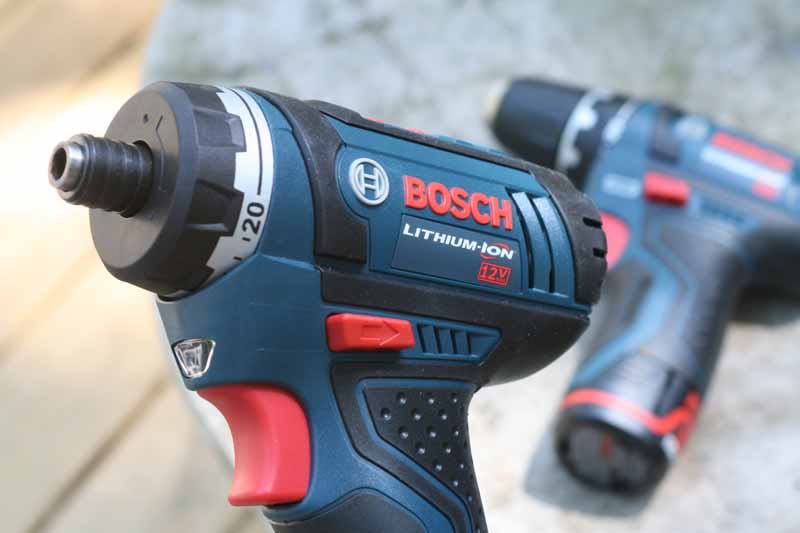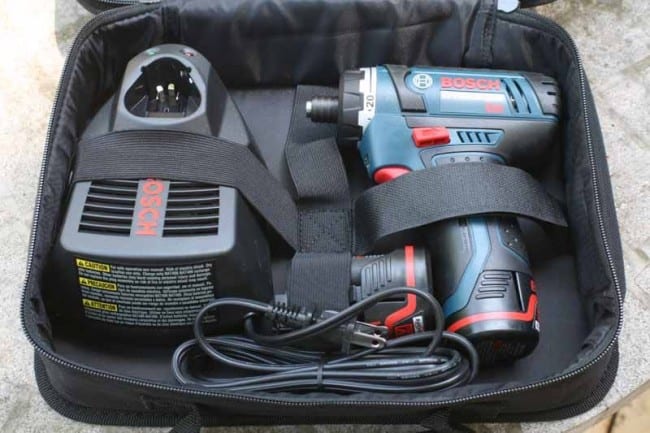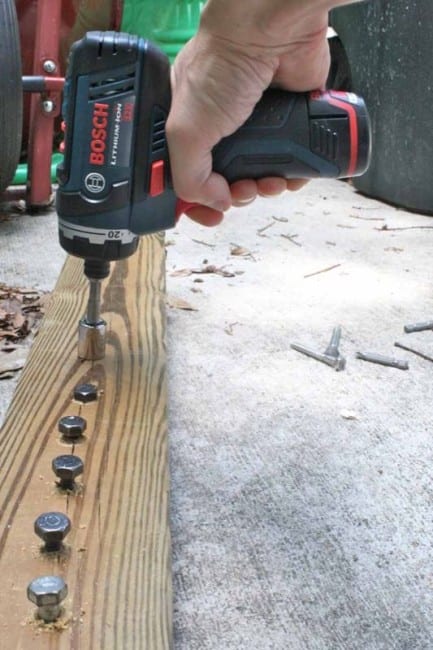Bosch’s new PS21-2A 12V Pocket Driver improves significantly upon last year’s model (the PS20-2A). Suffice it to say, Bosch has completely re-engineered the guts of this driver, tripling its torque and shrinking its footprint by a striking amount. They also beefed up the lithium-ion battery, giving the tool a nice tweak in the power department and showing that Bosch is serious about its technology. The purpose of the tool is to fill the needs of all manner of users, from contractors who want a handy, portable driver, to homeowners looking to obtain a beefy, lightweight solution for all their small project needs.
PS21-2A vs PS20-2A Pocket Driver
These new 12V sub-compact tools have been getting consistently smaller, as have their larger 18V brethren. Bosch’s Litheon line, however, presents some of the smallest tools we’ve ever seen, with power that belies their tiny frame. Like many smaller people who are used to having to do more to establish their prowess, these tools have an attitude.
While the Bosch PS31-2A slightly improved upon the Bosch PS30-2A by pulling back the chuck a bit onto the body, the Bosch PS21-2A 2-Speed Pocket Driver makes a quantum leap in that it shaves off nearly an inch from its predecessor! It literally looks like they took their old tool, heated it up, and pressed its nose against the wall until it crushed itself flat. The chuck has narrowed in depth and they recessed it behind the front edge of the tool. Even the rubber overmold experienced a face-lift. The LED light has been improved and its placement on the tool, and the lack of a protruding chuck, means that the work area receives a lot more illumination than before.
While all this is impressive in a physical and design sense, what really had us amazed was that Bosch was able to take this pocket driver from a paltry 80 in.-lbs of torque to 265 in-lbs! More than tripling the torque is a feat in and of itself, but doing so while shaving an inch in length off the tool is simply amazing.
BAT411 vs BAT412 Lithium-ion Batteries
Even the battery has gone from model BAT411 to BAT412. Since we could determine no improvement based upon the specs (both are still 10.8V x 1.3Ah = 14Wh in terms of power) we decided to test them in a simple run-time test. Equal specifications doesn’t rule out a tweaking to the electronics and we wanted to see if there was a practical result to the numerical model number change. Here are our results:
| BAT411 | BAT412 | |
|---|---|---|
| Runtime | 25:55 | 26:00 |
| First Power Drop | 15:00 | 23:30 |
| Final Power Drop | 18:00 | 24:00 |
From our battery tests we realized the difference between the two batteries right off. The BAT411 (original battery) ran at full power/speed until about 15 minutes when we noticed a first power drop (which we recorded as a drop in speed and the pitch of the motor). A second power drop occurred at around 18 minutes and was more significant, bringing the tool to a very slow speed, which continued to decline until the tool ceased operations at nearly 26 minutes. The BAT412 ran nearly full out for about 23 and a half minutes before dropping in speed. At 24 minutes it ran at a very slow speed until it ran out at around 26 minutes. It’s important to note that there was still some torque at even these low speeds – we couldn’t, for example, stop the hex bit easily with our fingers. The new BAT412 appears to better use the power and advantages of lithium-ion, running the tool at maximum capacity before it dropped suddenly at the end. In comparison, the BAT411 batteries operate more like NiMH batteries or NiCd batteries with a more gradual drain. We also noted that the Bosch Pocket Driver uses the entire shaft of the tool, all the way up to the hex chuck as a heat sink. It heats up a good amount during extended use, but it also draws that heat from the motor, extending its life and reducing wear and tear. This is an excellent design.
Build Quality
Like the PS31-2A and other 12V Litheon tools from Bosch, the PS21-2A arrived in a zippered case that provided little tool protection. The upside is that, since the PS21-2A has such a short depth, you can actually store it in the case with a standard bit still attached. The entire kit includes the Pocket Driver, two BAT412 lithium-ion batteries and a charger.
With the plethora of hex-shaft accessories for drivers these days, the Pocket Driver from Bosch presents a very speedy way to change bits and carry a handy tool that packs a good amount of punch into a tool with very little weight and size. You can really visualize how convenient a tool like this would be to simply throw into a tool bag or carry in the glove box of your work van. This is an all-purpose tool and there are even a healthy amount of hex shaft drill bits to enable this to be a true drill/driver solution for both the pro and casual user.
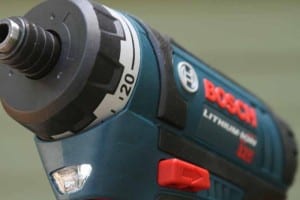
The Bosch PS21-2A 12V Max Pocket Driver uses the same high performance frameless motor as Bosch’s other compact 12V tools. In fact, if you look at the tools side-by-side you can see that they share the exact same form factor right up to the clutch. This made it even stranger that Bosch opted to not include an LED battery indicator on the PS21-2A as it did with the PS31-2A. There is even a mark for the LED module on the side of the tool just above the trigger, but the area is left intact instead of being removed to insert the triple LED display.
PS21-2A vs. PS30-2A Drill/Driver
When Bosch came out with the PS21-2A it was clear they aimed to perfect the 12V sub-compact tool market. But how well does the PS21-2A stack up, in terms of its improvements, to the older PS30-2A? Here’s a quick rundown on the two tools:
| PS21-2A | PS20-2A | |
|---|---|---|
| Torque | 265 in.-lbs. | 80 in.-lbs. |
| RPM | 0-350/0-1300 | 0-500 |
| Weight |
1.8 lbs. | 1.8 lbs. |
| Clutch |
20+1 | 10+1 |
| LED Light |
2nd Gen | 1st Gen |
| Battery |
BAT412 | BAT411 |
Clearly, the new tool, in addition to its greater torque, adds more clutch control, a new 2nd gen battery and a two-speed switch. Considering the price point of the PS21-2A is the same, or even a tad lower than the debut price of the PS20-2A, Bosch is making some dramatic advances in its Litheon line-up.
Testing and Use
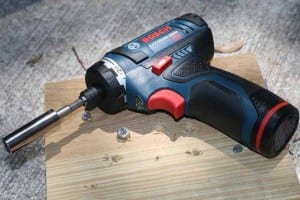
Screws were a different story. We drove a series of over 60 screws into our test piece of wood, sinking them as deep as we wanted. The PS21-2A was a smooth operator and drove all manner of screws quickly and easily. The variable speed trigger is excellent and allows a lot of control over the driving speed. This helps to reduce the amount of slippage and enables the tool to be a lot more convenient for assembly work, which often requires more finesse. Use this tool for even a short amount of time and you’ll appreciate the best thing about it – you get a lot of torque for very little weight.
Sound output by the Bosch PS21-2A reached only 83 dB SPL at our customary 36-inch distance. The noise is mostly a medium-high whine, representing the high speed motor, and it made the same amount of noise in both low and high speeds. The measured speed on the Bosch PS21-2A was 360 rpm in low speed (1) and 1210 rpm in high speed (2). That’s within a margin of error of 5 percent of the manufacturer’s stated numbers. Bosch continues to have fairly accurate and truthful specs, which is refreshing to see in this industry.
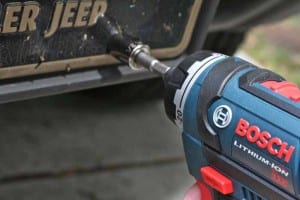
Conclusion
Short, small, powerful. There is a lot to like about the PS21-2A. We have never experienced a tool with quite the power-to-weight ratio of Bosch’s new Pocket Driver. I think the biggest decision for those looking to get into a new 12V system is going to be whether or not to get a standard chuck, like that with the PS31-2A, or go with the hex chuck of the PS21-2A. Once you decide to go with a hex chuck, there’s possibly no better choice than the Bosch 12V Pocket Driver. It’s simply one of the coolest tools we’ve ever used. About the only negative we found was the perplexing lack of a battery indicator on the tool. Given the nature of lithium ion, at least with Bosch’s new BAT412 batteries, you’re apt to pick up this tool some day and only get about 2 minutes out of it before it dies. For performance we gave the Bosch PS21-2A a 7/10. For value we give it an 8/10 since there is a ton of competition in this area, but we know of no other tool with such an impressive size-to-power ratio. This is an impressive tool and we can recommend it without reservation.

